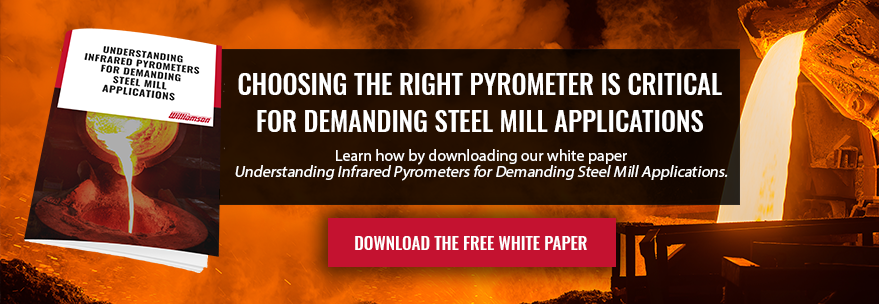
We have already discussed the many different areas of the steel making processes where you should be measuring temperature. Now we will discuss why monitoring the temperature during heating and cooling processes are critical to your steel products using the hot rolling mill as an example. The heating and cooling of steel dictates the mechanical properties and characteristics the final product will undertake. Therefore, carefully monitoring and controlling the temperature during heating and cooling processes allows for precise control of the final product properties.
Pre-heating steel is an important step whenever supplementary processes are to be performed. If the steel is not sufficiently pre-heated it could crack resulting in scrap or poor product quality. Over-heating wastes energy and can also adversely affect the properties of the steel. Maintaining a precise pre-heat temperature and accurately monitoring this temperature is often the critical first step in the steel-making process. Once your steel has been properly pre-heated it can then be held or soaked at a set temperature for a specific amount of time. This time temperature relationship is a critical step that must be adhered to in order to deliver the highest quality steel product to your customers.

After pre-heating, soaking and further manufacturing processes, the steel must be carefully cooled for safety and product quality. The cooling process for strip and plate mills is a bit different for wire mills. Wire products are generally thin enough that they can cool quickly with just air and fans. For strip and plate products water is the main form of cooling the steel. The cooling rate is a critical factor that affects the physical properties of the steel – especially for high-tensile strength and dual-phase steel alloys. Accurately monitoring the temperature throughout the cooling process ensures quality product and an efficient process.
There are several challenges associated with temperature measurement in the heating and cooling zones. These include: scale, emissivity variation, misalignment, steam, and low temperatures.
Single-wavelength pyrometers cannot compensate for scale, emissivity variation and misalignment. Two-color pyrometers cannot view through steam, cannot measure low temperatures, and are only OK at compensating for scale. Multi or dual-wavelength pyrometers are ideal because they can minimize and eliminate all the above listed interferences and temperature measurement challenges.
With accurate temperature measurement, operators can adjust the line speed to optimize the process while still maintaining quality product. Temperature control in the heating and cooling zones plays a critical role in determining the final physical properties of the steel product. Accurate temperature measurement is crucial to optimizing the steel making process. Selecting the right wavelength technology will give you the best results to optimize your hot rolling mill.
The heating and cooling zones are just a couple areas of the mill where the process can be optimized. To learn more about how to optimize other areas of the steel making process through proper steel infrared temperature sensor selection, download our white paper, Understanding Infrared Pyrometers for Demanding Steel Mill Applications.
Consult with one of Williamson’s Temperature Experts
We would love to discuss your temperature measurement application with you.


